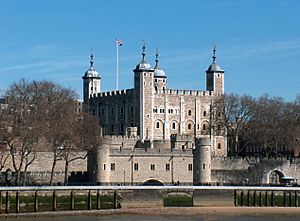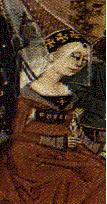Margaret de Clare, Baroness Badlesmere facts for kids
Quick facts for kids Margaret de Clare |
|
|---|---|
| Baroness Badlesmere | |
| Harness pendant of the 13th century, believed to bear Margaret's arms: Argent a saltire gules over all a label azure. | |
| Spouse(s) | Gilbert de Umfraville Bartholomew de Badlesmere, 1st Baron Badlesmere |
| Issue | |
| Margery de Badlesmere Maud de Badlesmere Elizabeth de Badlesmere Giles de Badlesmere, 2nd Baron Badlesmere Margaret de Badlesmere |
|
| Noble family | De Clare |
| Father | Thomas de Clare, Lord of Thomond |
| Mother | Juliana FitzGerald of Offaly |
| Born | ca 1 April 1287 Ireland or England |
| Died | 22 October 1333 or 3 January 1334 (disputed) Convent house of the Minorite Sisters, Aldgate, London |
Margaret de Badlesmere, Baroness Badlesmere (born de Clare; around 1 April 1287 – late 1333/early 1334) was an important Anglo-Norman noblewoman. She inherited lands and titles in her own right. She was also the wife of Bartholomew de Badlesmere, 1st Baron Badlesmere.
Margaret became the first recorded woman to be held prisoner in the Tower of London. She was jailed for a year, from November 1321 to November 1322. This happened because she ordered an armed attack on Isabella of France, who was the Queen of King Edward II of England.
Before the attack, Margaret had refused Queen Isabella entry to Leeds Castle. Margaret's husband, Baron Badlesmere, was the castle's governor. However, the castle legally belonged to Queen Isabella as part of her special property rights. Margaret surrendered the castle on 31 October 1321. This was after the King's army attacked it using large stone-throwing machines called ballistas. King Edward's capture of Leeds Castle helped start a conflict known as the Despenser War.
After her release from the Tower, Margaret chose to live a religious life. She joined the convent of the Minorite Sisters near Aldgate in London. King Edward gave her money to support herself there.
Contents
Early Life and Family
Margaret was born around 1 April 1287. She was the youngest child of Thomas de Clare, Lord of Thomond and Juliana FitzGerald of Offaly. Her grandfather was Richard de Clare, Earl of Hertford and Gloucester.
Margaret had two older brothers, Gilbert and Richard. Richard was killed in battle in 1318. She also had an older sister named Maud. Margaret's father died when she was only about five months old.
Inheriting Property
Margaret became an important heiress in 1321. This happened after her nephew, Thomas, died without children. Thomas was the son of her brother Richard. Margaret and her sister Maud were named as the next in line to inherit his property. This included the role of managing the Forest of Essex. It also included the town and castle of Thomond, plus many other properties in Ireland.
First Marriage
Before 1303, Margaret married Gilbert de Umfraville. He was the son of the Earl of Angus. As a wedding gift, they received two manors, Hambleton and Market Overton. Gilbert died young and without children before 1307. After his death, these manors became Margaret's property.
Second Marriage and Life with Bartholomew
Margaret married Bartholomew de Badlesmere, 1st Baron Badlesmere before June 1308. Bartholomew was an English soldier and a court official. He later became the 1st Baron Badlesmere. He was also the Governor of Bristol Castle.
Margaret became known as Baroness Badlesmere in October 1309. This was when her husband was officially called to Parliament as a Baron.
In 1319, Margaret was visiting Cheshunt Manor when about sixty people kidnapped her. They demanded money for her release. She was held for one night. The King's favorite, Hugh Despenser the Younger, rescued her the next day. The King ordered the arrest of twenty kidnappers, but they were all later forgiven.
Margaret's Children
Margaret and Baron Badlesmere had five children:
- Margery de Badlesmere (born 1308/1309). She married William de Ros, 2nd Baron de Ros and had six children.
- Maud de Badlesmere (born 1310). She married twice and had seven children with her second husband, John de Vere, 7th Earl of Oxford.
- Elizabeth de Badlesmere (born 1313). She married twice and had children from both marriages. Her first husband was Sir Edmund Mortimer.
- Giles de Badlesmere, 2nd Baron Badlesmere (born 1314). He married Elizabeth Montagu but had no children.
- Margaret de Badlesmere (born 1315). She married Sir John Tiptoft and had one son.
The Conflict at Leeds Castle
Margaret's husband, Baron Badlesmere, was the governor of the Royal Castle of Leeds in Kent. In October 1321, Queen Isabella was on a journey to Canterbury. She decided to stop at Leeds Castle. The castle was legally hers, as it was part of her property rights as Queen.
Baron Badlesmere was away at a meeting at the time. He had left Margaret in charge of the castle. He had also stored all his valuable items inside Leeds Castle for safety.
Margaret strongly disliked Queen Isabella. She refused to let the Queen enter the castle. Margaret told Isabella's marshal that the Queen had to find another place to stay. She said she would not let anyone into the castle without her husband's direct order.
After this message, Margaret ordered her archers to fire arrows at Queen Isabella. This happened when the Queen tried to approach the castle's outer gate. The unexpected attack killed six of the Queen's guards. This forced Isabella to quickly leave the castle and find another place to stay for the night.
Some historians believe that the King and Queen planned this event. They might have known Margaret would refuse entry. This would give King Edward a reason to gather support against his opponents.
The Siege and Its Aftermath
When King Edward heard about the attack on his Queen, he was very angry. He quickly gathered a large army and personally led them to Leeds Castle. He wanted to get revenge for the insult to the Queen.
The King's army attacked the castle for more than five days. They used large stone-throwing machines called ballistas. Margaret surrendered the castle on 31 October. She had hoped that other nobles who opposed the King would come to help her. However, no one arrived to support her.
After the King took control of the castle, he punished those who had resisted. The castle's manager and 12 of the soldiers were hanged. Margaret was arrested and sent to the Tower of London. Her five children and another relative were also sent with her. This made Margaret the first recorded woman to be imprisoned in the Tower. As she was taken through London, citizens loyal to the Queen insulted and yelled at her.
The Despenser War
The King's victory at Leeds Castle gave him more confidence. It helped him regain power that some nobles had taken from him. Many nobles who had been against Edward now joined him. They helped him put down a rebellion by the Marcher Lords. This rebellion was known as the Despenser War.
This conflict had started because the King's favorite, Hugh le Despenser the Younger, had taken lands that belonged to powerful Marcher barons. These events led to a tense situation in England. It eventually resulted in the King being forced to send the Despensers away. However, after capturing Leeds Castle, King Edward brought the Despensers back. This act had serious consequences. It led to the Despensers gaining too much power over the King. This eventually resulted in Queen Isabella and Roger Mortimer invading England in 1326. They took control, the Despensers were executed, and King Edward was removed from the throne.
Imprisonment and Release

Baron Badlesmere tried to explain his wife's actions at Leeds Castle. He said he had told her not to let anyone in without his specific orders, even the Queen. Because Margaret was imprisoned, Baron Badlesmere remained against the King. He later joined a rebellion led by the Earl of Lancaster.
Baron Badlesmere was captured after a battle in March 1322. He was executed in April 1322.
Margaret remained in the Tower of London until 3 November 1322. She was released after her son-in-law and five others promised to ensure her good behavior. Her children were likely released at the same time.
Later Life
After her release, Margaret went to live at the convent of the Minorite Sisters near Aldgate. The King showed her kindness. In February 1323, he gave her money each day to support herself. She also received a large part of her late husband's lands.
In July 1324, King Edward gave Margaret permission to visit her friends. She could go anywhere in the kingdom as long as she was ready to return if the King called her. It seems she later lived at Hambleton, Rutland.
In 1328, Margaret's son Giles successfully had his father's punishment reversed. He then became the 2nd Baron Badlesmere. By this time, Edward III was King. However, Queen Isabella and her ally, Roger Mortimer, truly ruled England. They were the King's regents, meaning they ruled for him while he was young. Edward II had been removed from power in January 1327 and was likely murdered later that year.
Queen Isabella and Lord Mortimer's rule ended in October 1330. Young King Edward III, who was nearly 18, had Mortimer executed. Queen Isabella was sent away to live quietly for the rest of her life.
Margaret died sometime between October 1333 and January 1334.
Seal
In 1328, Margaret's personal seal showed three shields. These shields represented her parents. There was also a shield combining the symbols of her two deceased husbands.


